New Microgrid Architectures for Telecommunication Base Stations in Non-Interconnected Zones: A Colombian Case Study
Abstract
1. Introduction
- This paper presents a new design for an isolated microgrid for telecommunication base stations (BTSs) in non-interconnected areas.
- This research presents new control architectures, energy management, and system optimization, including technical–economic analysis.
- The research outcome highlights the economic and social benefits for both local communities and mobile phone service providers.
- This research aims to establish a guideline on how these factors affect the focus region of this research.
2. Methodology
2.1. Microgrids in Non-Interconnected Areas in the Colombian Context
- -
- Areas located near the National Interconnected System (NIS): a network extension of up to 1.5 km is proposed to connect the isolated zone.
- -
- Remote or hard-to-reach areas: Off-grid solutions are recommended, typically consisting of individual solar panel systems for dispersed households.
- -
- Densely populated zones: Microgrid (MG) systems are suggested to supply energy collectively and autonomously.
2.2. New Microgrid Design for Base Stations in Telecommunications: The Colombian Case Study
3. Simulation Results
3.1. Microgrid Planning and Sizing
3.2. Feasibility Analysis
4. Conclusions
Author Contributions
Funding
Data Availability Statement
Acknowledgments
Conflicts of Interest
References
- Alzate, Y.L.; Gómez-Luna, E.; Vasquez, J.C. Innovative Microgrid Services and Applications in Electric Grids: Enhancing Energy Management and Grid Integration. Energies 2024, 17, 5567. [Google Scholar] [CrossRef]
- Natalia, B.G. Design Proposal for a Microgrid in the Community of Santa Elena, Pérez Zeledón, Based on Whites Lane Smart Micro Grid. Rev. Tecnol. Marcha 2017, 30, 55–62. Available online: https://www.scielo.sa.cr/scielo.php?script=sci_arttext&pid=S0379-39822017000500055 (accessed on 16 July 2025).
- UPME Mining-Energy Planning Unit. Indicative Plan for the Expansion of Electric Energy Coverage PIEC. 2024. Available online: https://docs.upme.gov.co/SIMEC/Energia%20Electrica/PIEC/2024-2028/PIEC_2024-2028_Vfinal.pdf (accessed on 5 June 2025).
- Moya, S.L. Infrastructure for an Urban Mobile Phone Base Station BTS. Undergraduate Thesis, Department of Telecommunications, Universidad de Sevilla, Sevilla, Spain, 2015; pp. 20–21. Available online: https://ereding.etsi.us.es/bibing/proyectos/use/abreproy/12306/fichero/Infraestructura+para+una+BTS+urbana.pdf (accessed on 5 May 2025).
- Carvajal, M.I.; Gómez-Luna, E.; Sáenz, E.M. Methodology for the Analysis of Technical Feasibility in the Installation of microgrids. J. Eng. Sci. Technol. Rev. 2019, 12, 176–187. [Google Scholar] [CrossRef]
- Rivera, E.L.; Marlés-Sáenz, E.; Gómez-Luna, E. Requirements and tests of the control system of a microgrid, according to the IEEE Std 2030-7-2017 and IEEE Std 2030.82018 standards. Ing. Y Compet. 2022, 24, 1–21. [Google Scholar] [CrossRef]
- John, C.; Eduardo, G.L.; Juan, V. A New Digital Twins-Based Overcurrent Protection Scheme for Distributed Energy Resources Integrated Distribution Networks. Energies 2023, 16, 5545. [Google Scholar] [CrossRef]
- Communications Regulation Commission CRC. Resolution 5050. 2016. Available online: https://colombiatic.mintic.gov.co/679/articles-51068_doc_norma.pdf (accessed on 16 May 2025).
- CREG Energy and Gas Regulation Commission. Resolution 030. 2018. Available online: https://gestornormativo.creg.gov.co/gestor/entorno/docs/resolucion_creg_0030_2018.htm (accessed on 16 May 2025).
- Energy and Gas Regulation Commission CREG. Resolution 038. 2018. Available online: https://gestornormativo.creg.gov.co/gestor/entorno/docs/resolucion_creg_0038_2018.htm (accessed on 15 July 2025).
- UPME Mining and Energy Planning Unit. Resolution 203. 2020. Available online: https://www1.upme.gov.co/Normatividad/203-2020.pdf (accessed on 5 June 2025).
- Ley 1715 de 2014. Gestor Normativo—Función Pública. Available online: https://www.funcionpublica.gov.co/eva/gestornormativo/norma.php?i=57353 (accessed on 15 July 2025).
- CREG Energy and Gas Regulation Commission. Resolution 186. 2020. Available online: http://apolo.creg.gov.co/Publicac.nsf/1c09d18d2d5ffb5b05256eee00709c02/f6e0e4fedccfefb40525861b004e9b26/$FILE/Creg186-2020.pdf (accessed on 1 July 2025).
- Castrillón, L.F.U. Marco conceptual regulatorio de la transición minero-energética justa y comunidades energéticas en Colombia. Rev. De La Fac. De Derecho De México 2024, 74, 207–234. [Google Scholar] [CrossRef]
- Government of Chocó, Departmental Development Plan. 2020. Available online: https://rap-pacifico.gov.co/wp-content/uploads/2020/07/choco-final-pddd.pdf (accessed on 15 September 2025).
- Kryonidis, G.C.; Kontis, E.O.; Papadopoulos, T.A.; Pippi, K.D.; Nousdilis, A.I.; Barzegkar-Ntovom, G.A.; Boubaris, A.D.; Papanikolaou, N.P. Ancillary services in active distribution networks: A review of technological trends from operational and online analysis perspective. Renew. Sustain. Energy Rev. 2021, 147, 111198. [Google Scholar] [CrossRef]
- Alejandro, A.M.; Alexis, C.R.; Ángel, R.A.; Deyslen, H.; Miguel, A.M. Protocols and topologies used in the communication systems of electrical microgrids. Cienc. Ing. Y Apl. 2021, 4, 81–95. [Google Scholar] [CrossRef]
- Danny, T.; Fabricio, M.; Edwin, G. Feasibility analysis of electrical microgrids with high penetration of renewable resources in urban areas: Case study of residential condominiums. J. Enfoque UTE 2021, 12, 19–36. [Google Scholar] [CrossRef]
- Jorge, O.; Juan, E.; Nuno, G. Analysis of technical- economic viability of small-scale photovoltaic systems with different storage technologies. J. Maskana 2017, 8, 319–330. [Google Scholar]
- Calderón, D.; Folgado, F.J.; González, I.; Calderón, A.J. Implementation and Experimental Application of Industrial IoT Architecture Using Automation and IoT Hardware/Software. Sensors 2024, 24, 8074. [Google Scholar] [CrossRef] [PubMed]
- Escobar-Orozco, L.F.; Gómez-Luna, E.; Marlés-Sáenz, E. Identification and analysis of technical impacts in the electric power system due to the integration of microgrids. Energies 2023, 16, 6412. [Google Scholar] [CrossRef]
- Hidalgo, D.G.; Saavedra-Montes, A.J. Una metodología de diseño de Micror redes para zonas no interconectadas de Colombia. J. TecnoLógicas 2017, 20, 39–53. [Google Scholar] [CrossRef]
- Giraldo, J.C.C.; Vivanco, J.C.; Llanos, J.D.N.; Luna, E.G. Innovative approach for the analysis of electromagnetic transients generated by the integration of distributed energy resources in power systems. IEEE Lat. Am. Trans. 2025, 23, 232–238. [Google Scholar] [CrossRef]
- Cerón, J.A.; Gómez-Luna, E.; Vasquez, J.C. Driving the Energy Transition in Colombia for Off-Grid Regions: Microgrids and Non-Conventional Renewable Energy Sources. Energies 2025, 18, 1010. [Google Scholar] [CrossRef]
- Yeferson, A.; Eduardo, G.L.; Vasquez, J.C. Remuneration of Ancillary Services from Microgrids: A Cost Variation-Driven Methodology. Energies 2025, 18, 5177. [Google Scholar] [CrossRef]
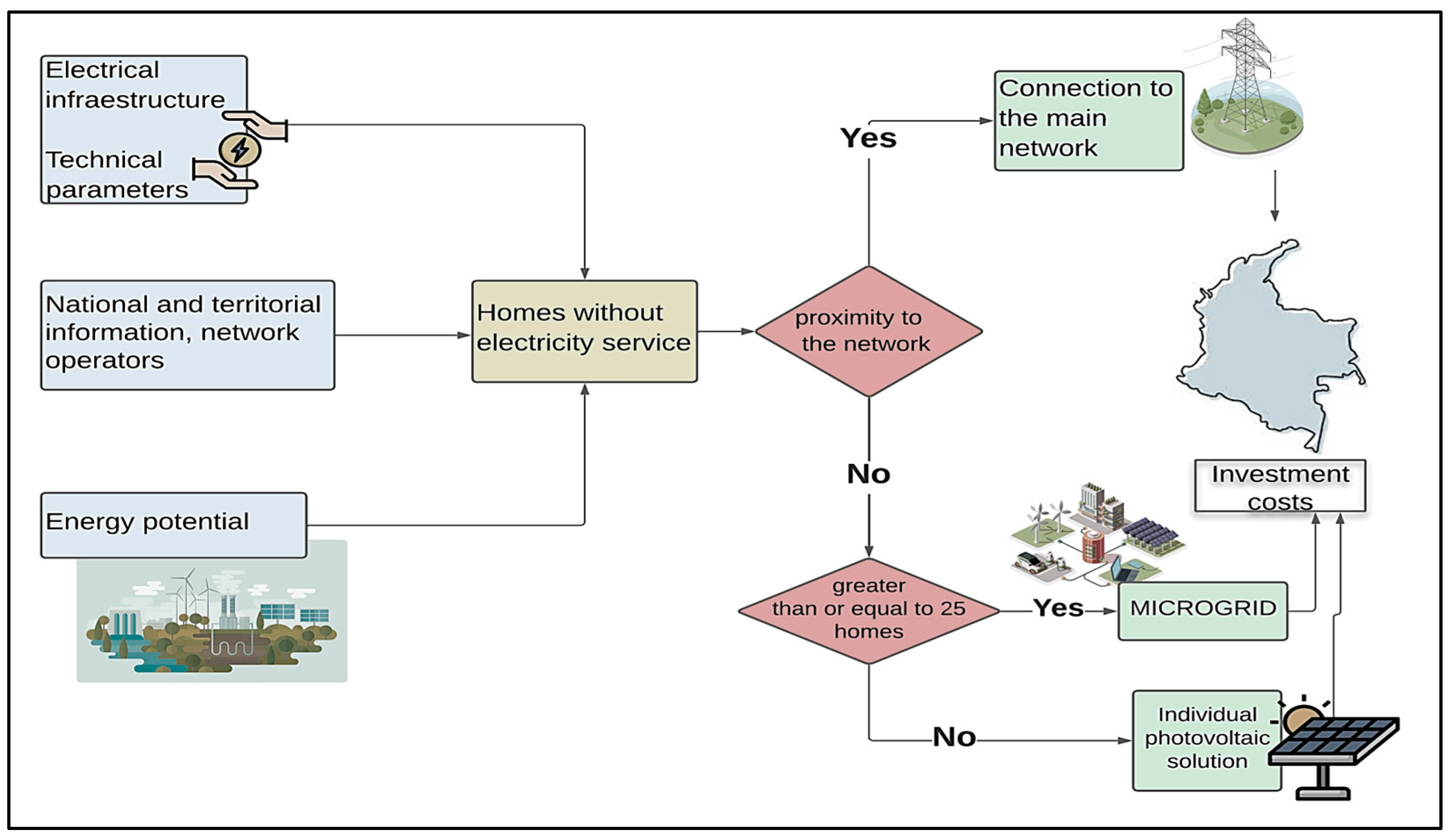
 Microgrid solutions.
Microgrid solutions.  Individual photovoltaic solutions.
Individual photovoltaic solutions.
 Microgrid solutions.
Microgrid solutions.  Individual photovoltaic solutions.
Individual photovoltaic solutions.
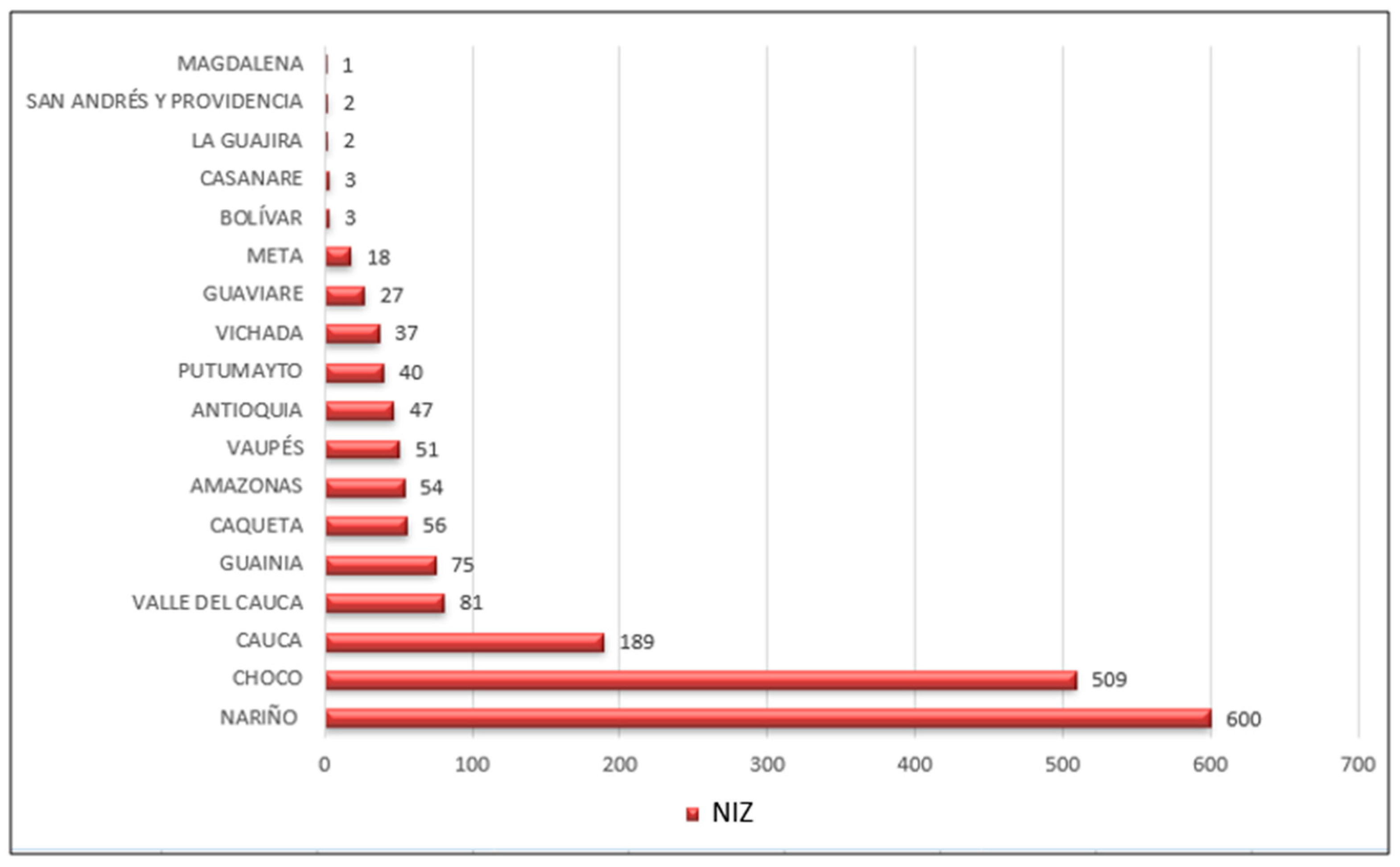
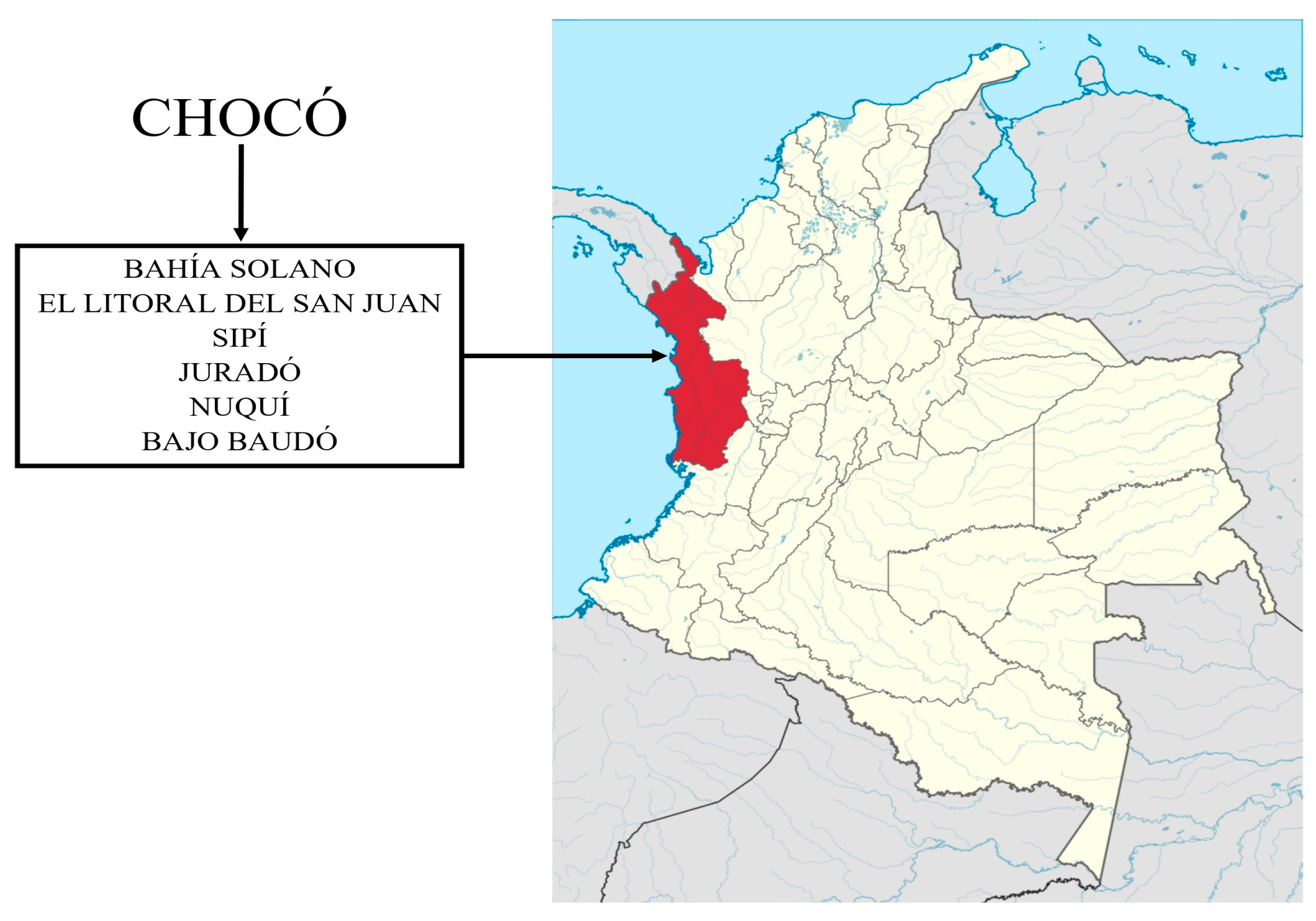
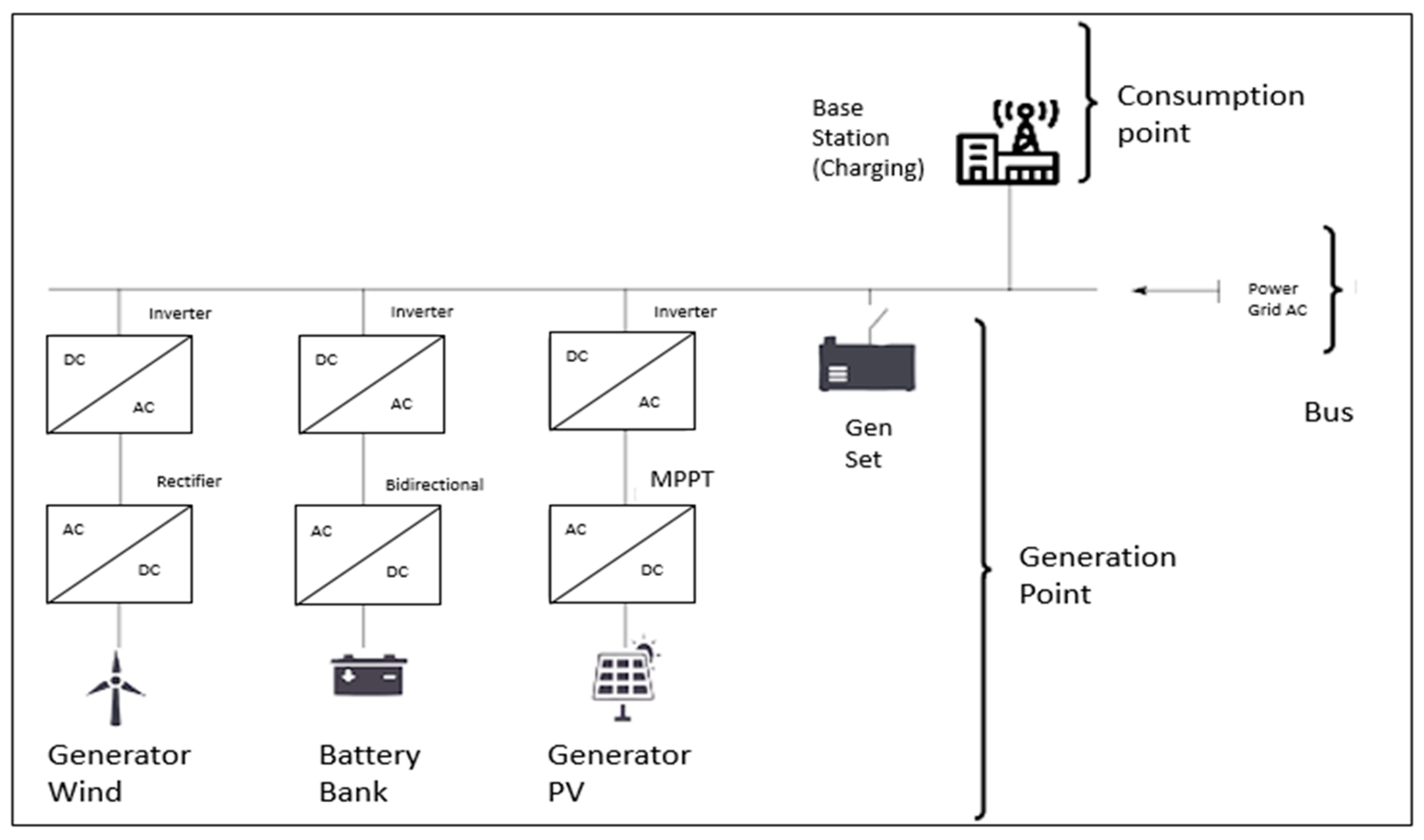

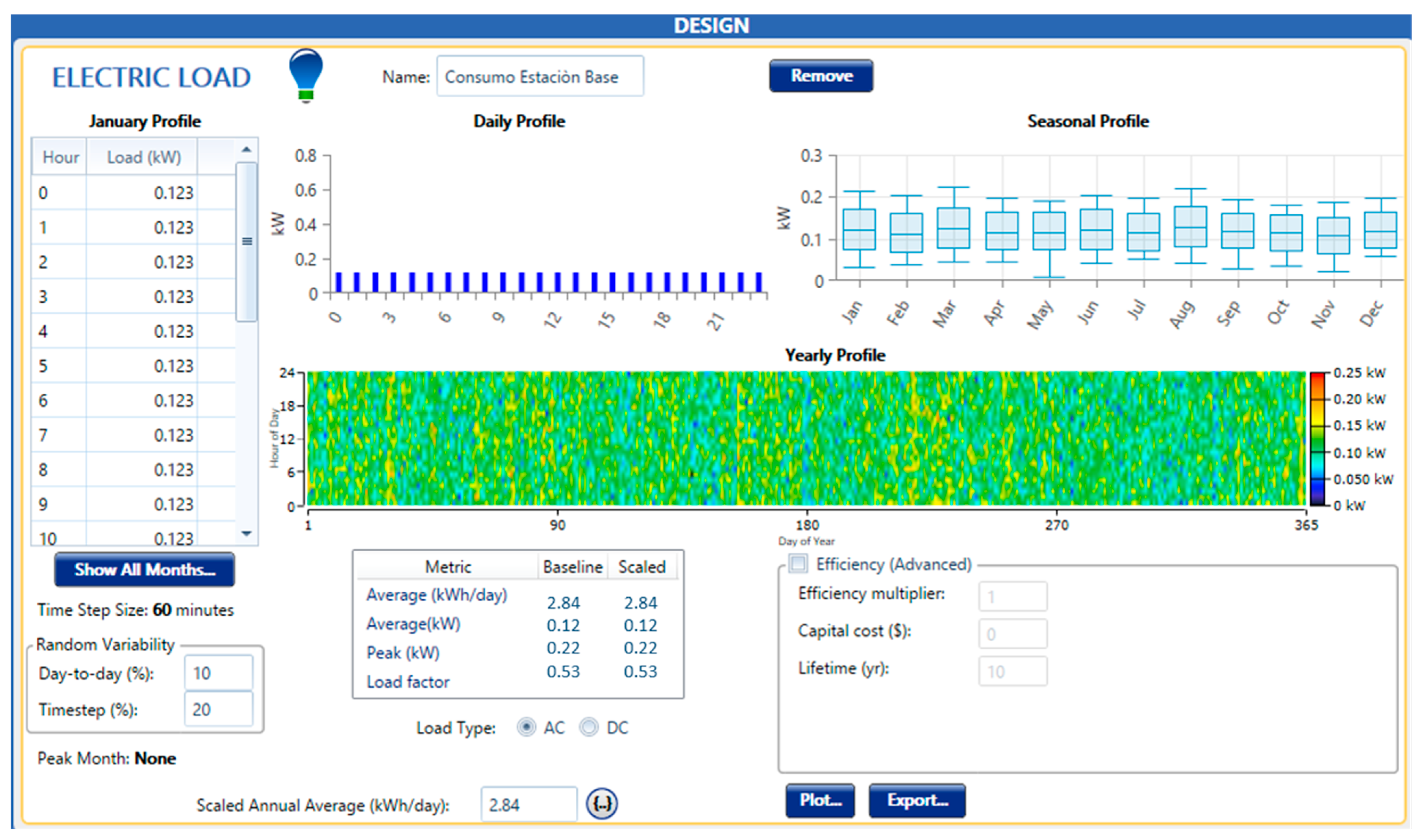

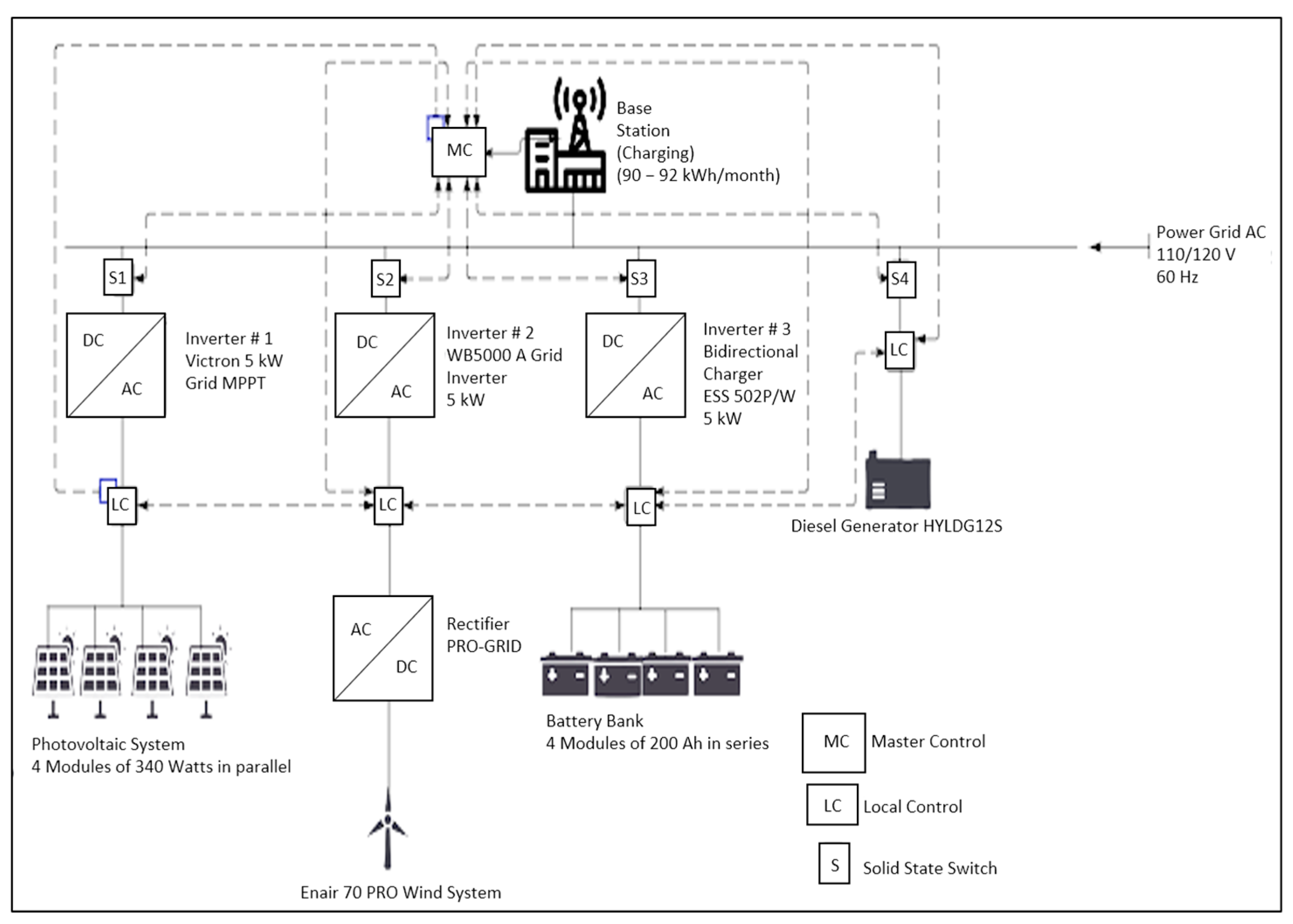
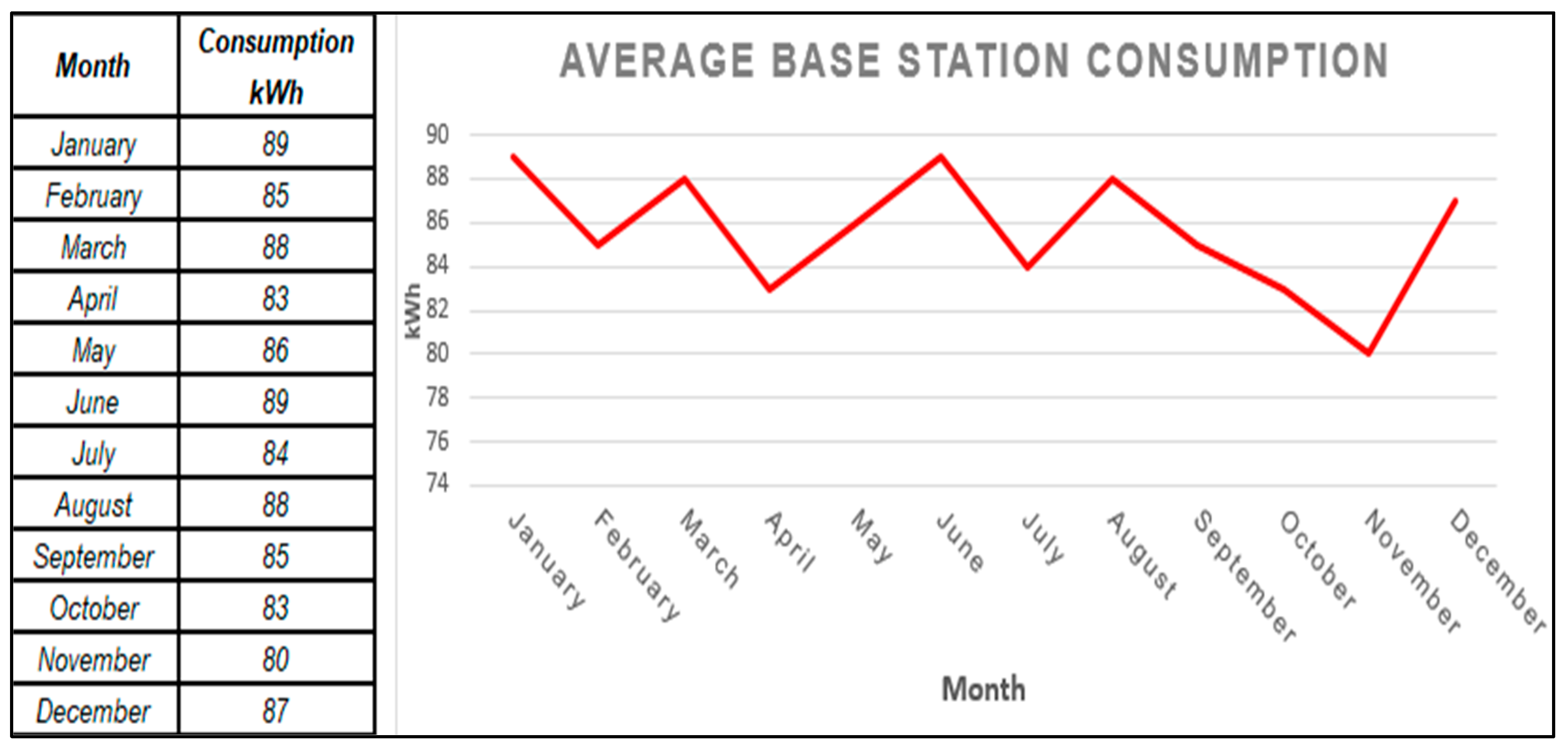
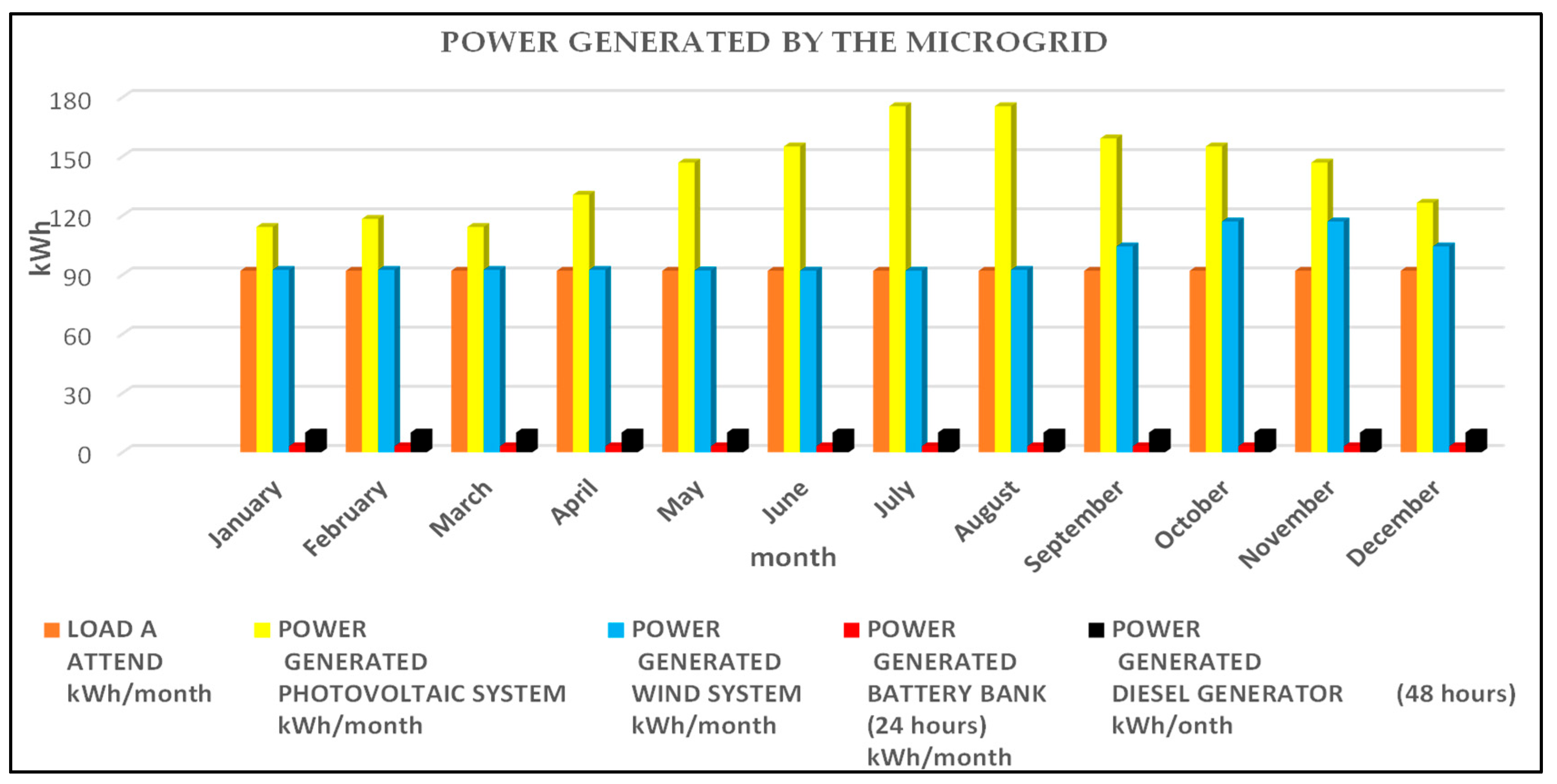
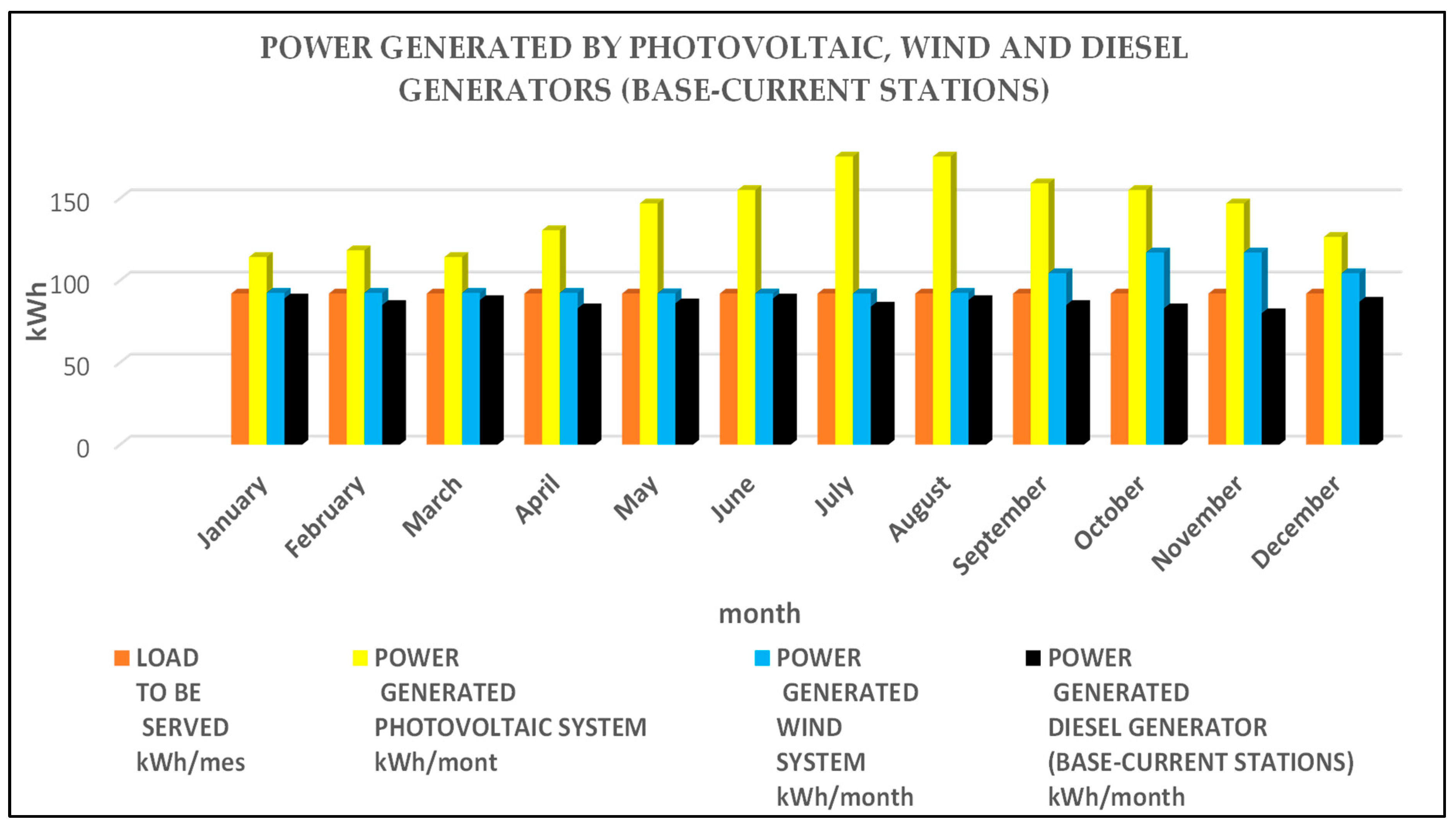
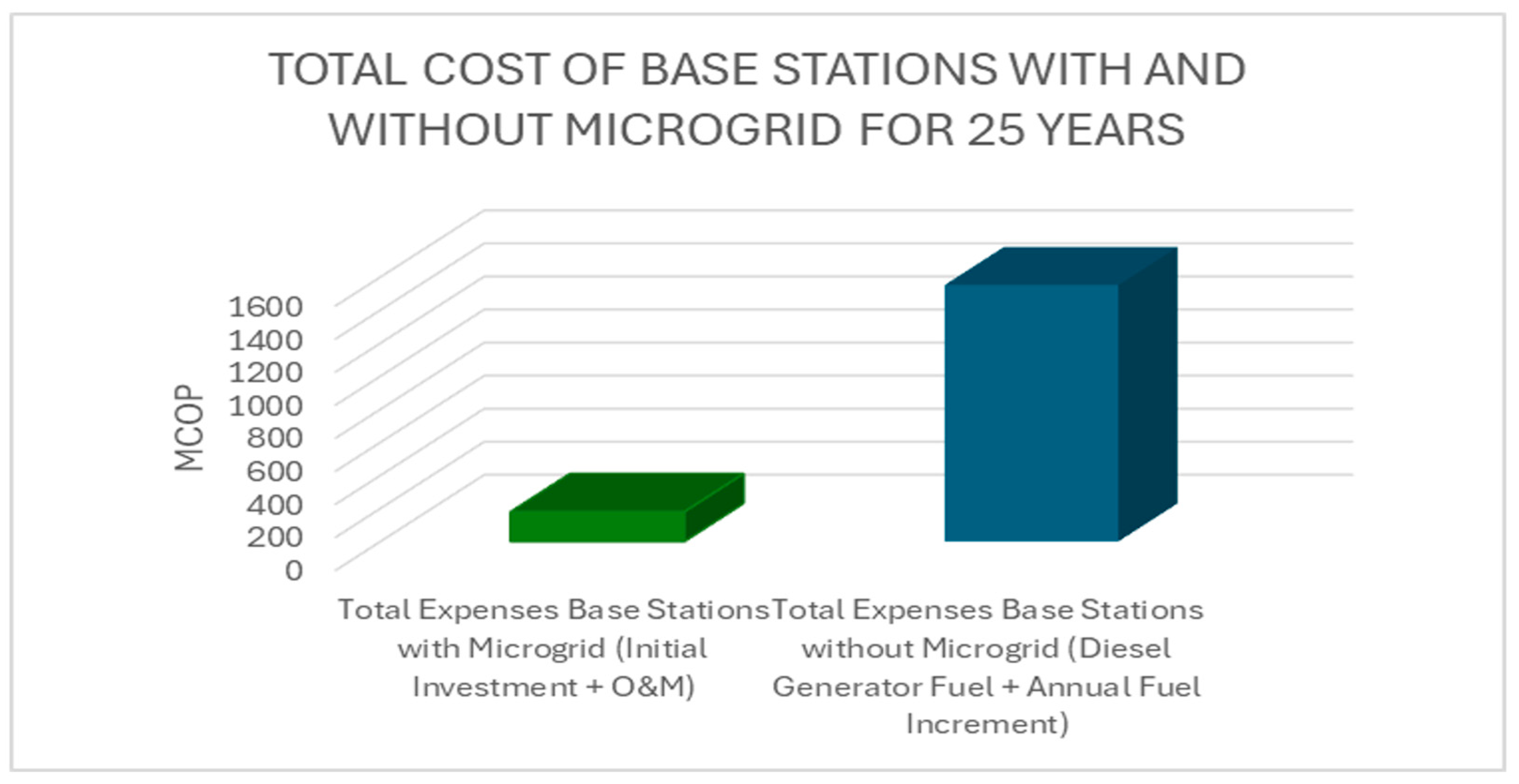
| Typology of Localities | Type 1 | Type 2 | Type 3 | Type 4 |
|---|---|---|---|---|
| Number of users | 1 to 50 | 51 to 150 | 151 to 300 | more than 300 |
| Monthly demand (kWh/user) | 33.6 | 45 | 76 | greater than 76 |
| Daily consumption (kWh/users) | 1.12 | 1.5 | 2.53 | greater than 2.53 |
| Daily consumption range (kWh) | 1.12 to 56 | 76.5 to 225 | 11,476 to 22,800 | over 22,800 |
| Hours of service (h) | 4 | 5 | 8 | 10 to 14 |
| Department DANE | Code DANE Municipality | Municipality DANE | Base Stations | Communication Technologies | Electrical Supply |
|---|---|---|---|---|---|
| CHOCO | 27,075 | BAHÍA SOLANO | CHO.Bahia Solano | GSM/UMTS/LTE | Power Plants |
| CHO.El Valle | |||||
| 27,250 | EL LITORAL DEL SAN JUAN | CHO.Docordo | |||
| 27,745 | SIPÍ | CHO.Sipi | |||
| 27,372 | JURADÓ | CHO.Bahia Cupica | |||
| CHO.Jurado | |||||
| 27,495 | NUQUI | CHO.Nuqui | |||
| 27,077 | BAJO BAUDÓ | CHO.Pizarro |
| Item | Description | Specification | Quantity |
|---|---|---|---|
| 1 | Photovoltaic panel | JAM60S10 340Wp | 4 |
| 2 | Wind generator | ENAIR 70PRO | 1 |
| 3 | Batteries | UU 12–200 200 Ah/12 V | 4 |
| 4 | Diesel generator | HYLDG12S 10 kW | 1 |
| 5 | Photovoltaic grid inverter | VICTRON 5 Kw | 1 |
| 6 | Wind load rectifier | PRO-GRID | 1 |
| 7 | Wind generator network inverter | WB5000 A 5 KW | 1 |
| 8 | Bidirectional inverter charger | ESS 502 P/W 5 kW | 1 |
| Item | Description | Value (MCOP) |
| 1 | Net production cost NPC (COP) | 126 |
| 2 | Kilowatt-hour cost LCOE (COP/kWh) | 0.009382 |
| 3 | Net capital cost CAPEX (COP) | 104 |
| 4 | Fuel cost per year (CPO/year) | 0 |
| 5 | Operating cost per year OPEX (COP/year) | 2.15 |
| 6 | Percentage of renewable energies (%) | 100 |
| Month | Load a Attend kWh/month | Power Generated Photovoltaic System kWh/month | Power Generated Wind System kWh/month | Power Generated Battery Bank (24 h) kWh/month | Power Generated Diesel Generator (48 h) kWh/month |
|---|---|---|---|---|---|
| January | 92 | 114.24 | 92.42 | 3.036 | 10 |
| February | 92 | 118.32 | 92.42 | 3.036 | 10 |
| March | 92 | 114.24 | 92.42 | 3.036 | 10 |
| April | 92 | 130.56 | 92.42 | 3.036 | 10 |
| May | 92 | 146.88 | 92.13 | 3.036 | 10 |
| June | 92 | 155.04 | 92.02 | 3.036 | 10 |
| July | 92 | 175.44 | 92.02 | 3.036 | 10 |
| August | 92 | 175.44 | 92.42 | 3.036 | 10 |
| September | 92 | 159.12 | 104.33 | 3.036 | 10 |
| October | 92 | 155.04 | 116.97 | 3.036 | 10 |
| November | 92 | 146.88 | 116.97 | 3.036 | 10 |
| December | 92 | 126.48 | 104.33 | 3.036 | 10 |
| Month | Load to Be Served kwh/mes | Power Generated by the Photovoltaic System kwh/month | Power Generated by the Wind System kwh/month | Power Generated by the Diesel Generator (Base-Current Stations) kwh/month |
|---|---|---|---|---|
| January | 92 | 114.24 | 92.42 | 89 |
| February | 92 | 118.32 | 92.42 | 85 |
| March | 92 | 114.24 | 92.42 | 88 |
| April | 92 | 130.56 | 92.42 | 83 |
| May | 92 | 146.88 | 92.13 | 86 |
| June | 92 | 155.04 | 92.02 | 89 |
| July | 92 | 175.44 | 92.02 | 84 |
| August | 92 | 175.44 | 92.42 | 88 |
| September | 92 | 159.12 | 104.33 | 85 |
| October | 92 | 155.04 | 116.97 | 83 |
| November | 92 | 146.88 | 116.97 | 80 |
| December | 92 | 126.48 | 104.33 | 87 |
| Total Expenses Base Stations with Microgrid (Initial Investment + O&M) (MCOP) | Total Expenses Base Stations Without Microgrid (Diesel Generator Fuel + Annual Fuel Increment) (MCOP) |
|---|---|
| COP 179.750 | COP 1551.312 |
Disclaimer/Publisher’s Note: The statements, opinions and data contained in all publications are solely those of the individual author(s) and contributor(s) and not of MDPI and/or the editor(s). MDPI and/or the editor(s) disclaim responsibility for any injury to people or property resulting from any ideas, methods, instructions or products referred to in the content. |
© 2025 by the authors. Licensee MDPI, Basel, Switzerland. This article is an open access article distributed under the terms and conditions of the Creative Commons Attribution (CC BY) license (https://creativecommons.org/licenses/by/4.0/).
Share and Cite
Gómez-Luna, E.; Palacios, M.A.; Vasquez, J.C. New Microgrid Architectures for Telecommunication Base Stations in Non-Interconnected Zones: A Colombian Case Study. Energies 2025, 18, 5499. https://doi.org/10.3390/en18205499
Gómez-Luna E, Palacios MA, Vasquez JC. New Microgrid Architectures for Telecommunication Base Stations in Non-Interconnected Zones: A Colombian Case Study. Energies. 2025; 18(20):5499. https://doi.org/10.3390/en18205499
Chicago/Turabian StyleGómez-Luna, Eduardo, Mario A. Palacios, and Juan C. Vasquez. 2025. "New Microgrid Architectures for Telecommunication Base Stations in Non-Interconnected Zones: A Colombian Case Study" Energies 18, no. 20: 5499. https://doi.org/10.3390/en18205499
APA StyleGómez-Luna, E., Palacios, M. A., & Vasquez, J. C. (2025). New Microgrid Architectures for Telecommunication Base Stations in Non-Interconnected Zones: A Colombian Case Study. Energies, 18(20), 5499. https://doi.org/10.3390/en18205499









